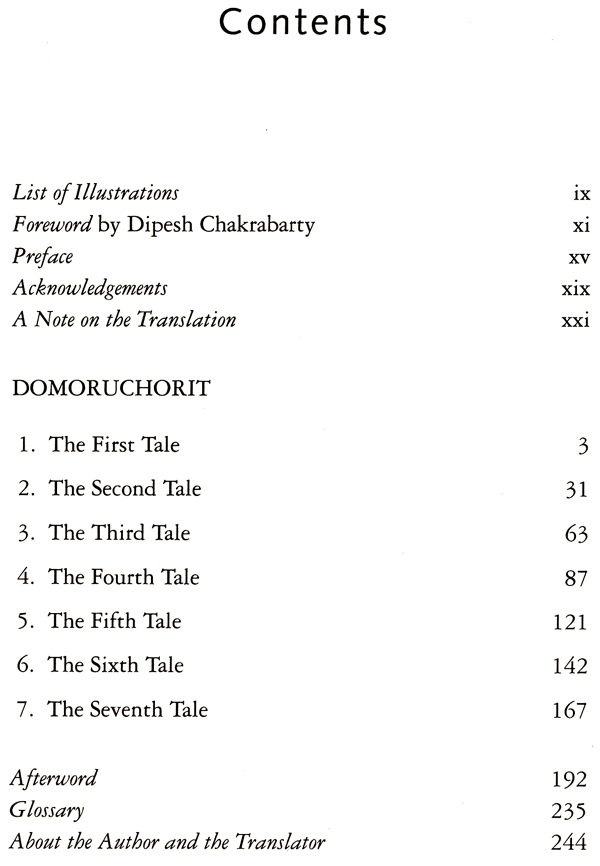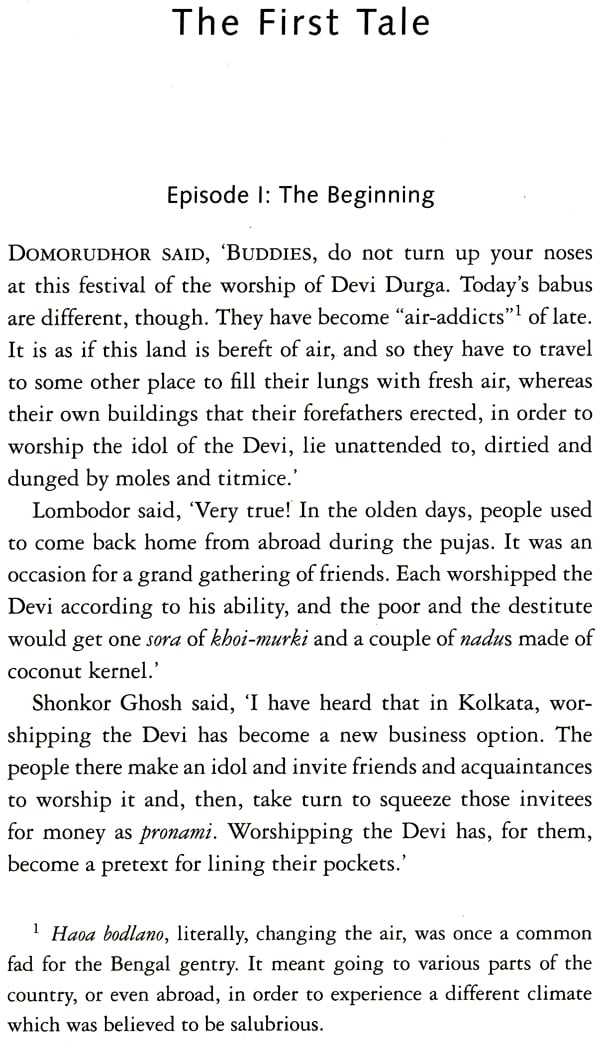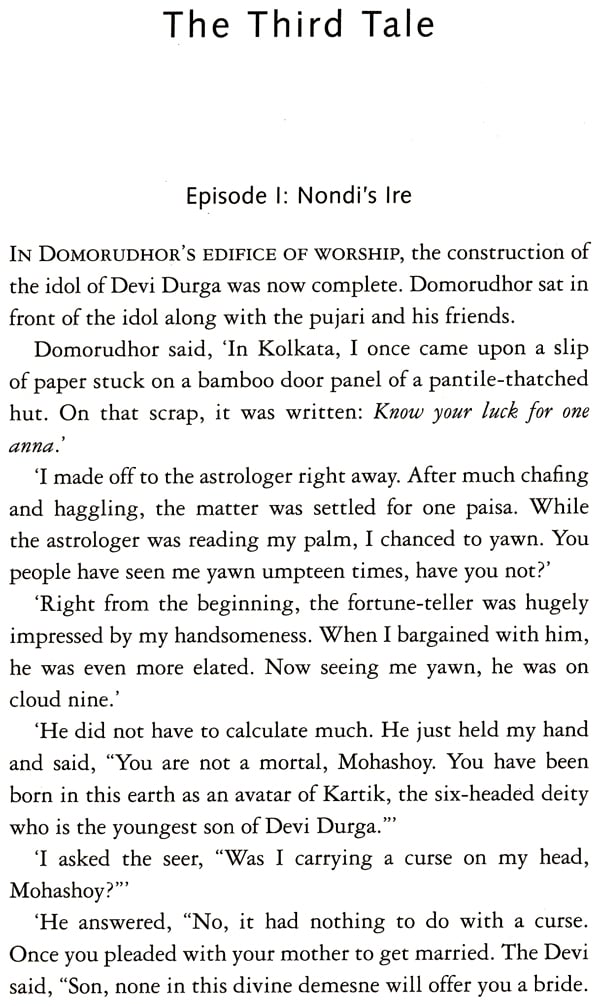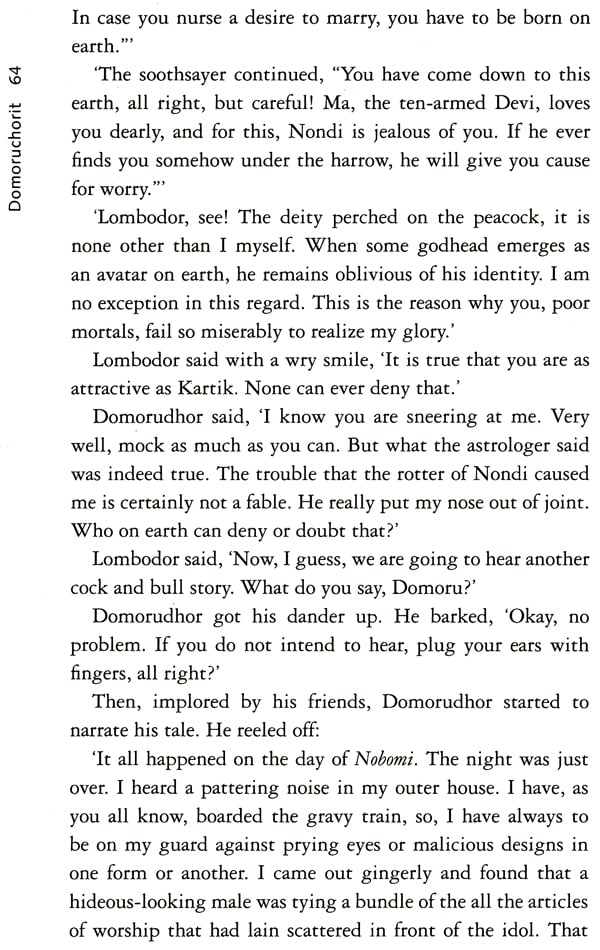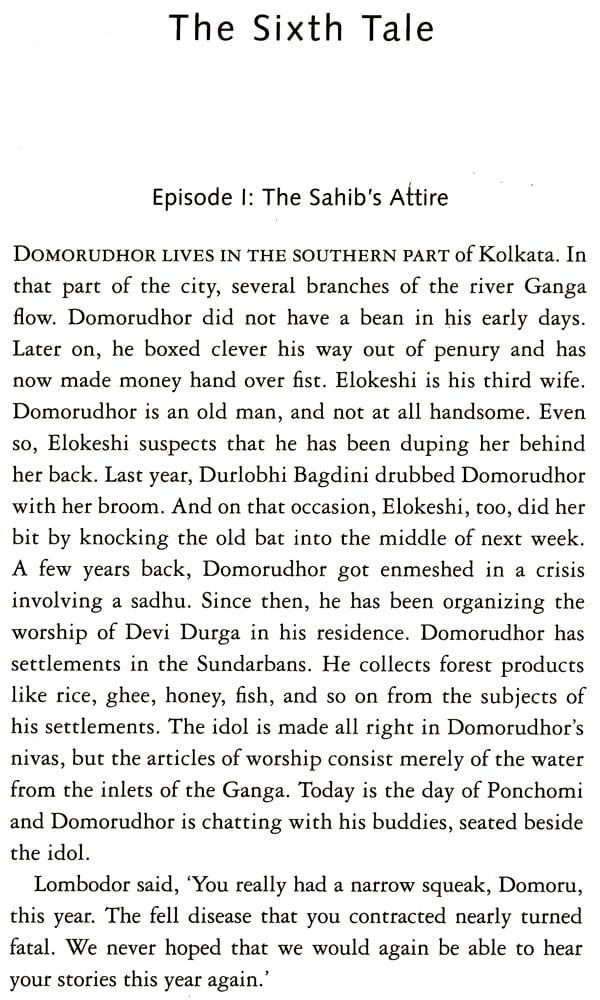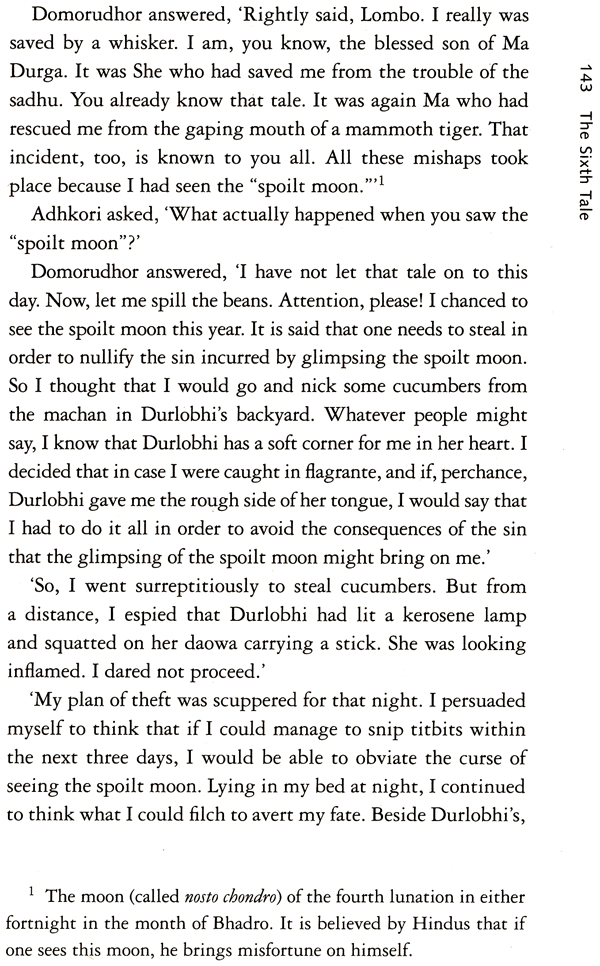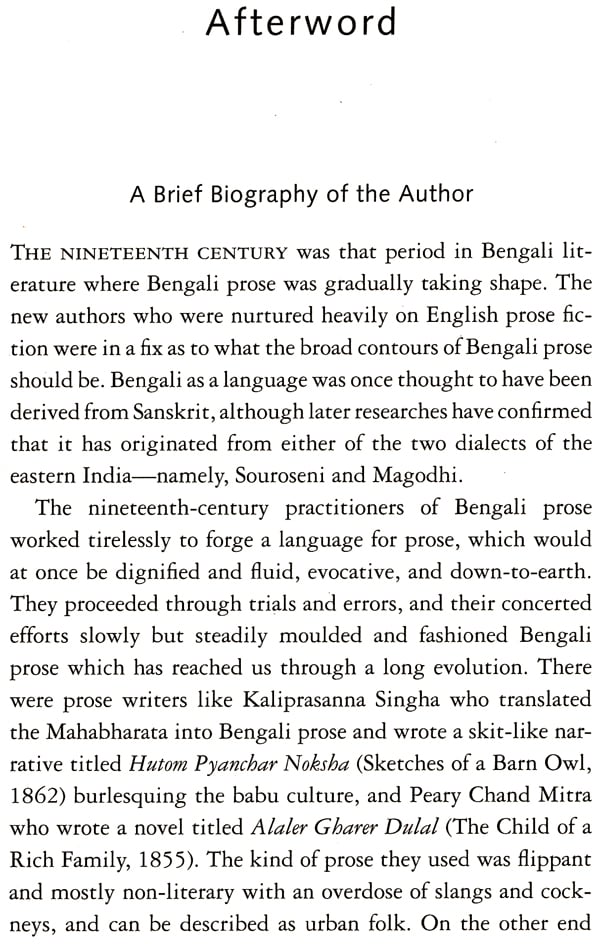
Domoruchorit (Stunning Tales from Bengali Adda)
Book Specification
| Item Code: | NAR980 |
| Author: | Dipesh Chakrabarty |
| Publisher: | Oxford University Press |
| Language: | English |
| Edition: | 2017 |
| ISBN: | 9780199477395 |
| Pages: | 268 (Throughout B/W Illustrations) |
| Cover: | PAPERBACK |
| Other Details | 8.50 X 5.50 inch |
| Weight | 260 gm |
Book Description
Troilokyonath Mukhopadhyay (1847-1919) was one of the prominent writers of fiction in nineteenth-century Bengal, whose stories are replete with sparkling wit, hilarious and unexpected turns of events, and caustic social satire.
Arnab Bhattacharya is a critic, author, editor, and translator, and a guest lecturer at the Department of Comparative Literature, Jadavpur University, Kolkata, India.
SPEAKING ABOUT TROILOKYONATH, I am reminded of the notion of Inerrability' that Jacques Derrida developed in his 1971 essays 'Signature, Event, Context' and 'White Mythology: Metaphor in the Text of Philosophy', and later included in his book Margins of Philosophy. By this term, Derrida indicates the simultaneity of the sameness and difference of a sign when used in varying contexts. The point is that when a sign, a word, for example, is used in multiple contexts, it remains the same phonetically, semantically, and in some other respects, but semiologically it takes on different significations, depending on the contexts it is used in. While attempting to write a preface to my third translation of Troilokyonath Mukhopadhyay's literature, I feel threatened by the prospect of repeating certain things already mentioned in the prefaces to my earlier translations of the same author, namely, Of Ghosts and Other Perils (2013) and Konkaboti: The Extraordinary Journey of a Village Girl (2015). But I take heart from the argument that if every sign is iterable, then my rehashing of some old stuff should not be deemed as something exceptional and/or exceptionable. Words are not biodegradable, so there is little harm in recycling them, I suppose.
One of the most memorable moments of my adolescence was when I came upon a copy of Troilokyonath's debut novel Konkaboti. It was a serendipitous discovery, but to claim this is to say the least about the changes that the book caused in my perception of things. A more telling way to describe the change is perhaps to maintain that Troilokyonath happened in my life at that time. He happened when I was feeling increas-ingly alienated from the adult world, and, being an inveterate introvert, was not too comfortable in my peer group either. I needed a third space that I could call my own and share at my will. Troilokyonath provided that space with elan; and not only that, he kindled my creative energy needed to inhabit that space. In fact, reading Troilokyonath engendered an altogether new perception of reality in me. Before I read him, I used to take reality as a given, as an inexorable and relentless symmetry of things to which my only response was to fit into or to cope with. Troilokyonath taught me to break free of that siege mentality, to cut loose from those 'mind-forged manacles' that allow only a one-dimensional view of things. Apart from giving me immense pleasure, Troilokyonath gave me that priceless freedom of mind and quiet confidence that later on enabled me to deal with words and worlds on my own terms. Anthropologists like Victor Turner opine that an individual crisis includes a limen (threshold) that acts as an interface between two stable phases of social life. This limen spawns what they call a luminal space, which is usually occupied by rituals and carnivals, triggering a radical change in some pre-conceived notions and generating a new perspective. Arnold van Gennep, a noted nineteenth-century Dutch-German-French ethnographer, called these rituals rite de passage (rite of passage' in its anglicized form)-a term later adopted by cultural anthropologists and literary critics. Troilokyonath's literature was my 'rite of passage', for it graduated me from one perception of reality to an altogether different one, and my translations of Troilokyonath have always been a reverential acknowledgement of that fact.
THERE IS A LONG AND VENERABLE TRADITION of Bengali and other scholars translates into English, literature from Bengal-texts spanning a long period, from precolonial times to the contemporary, and covering the entire geography of West Bengal and Bangladesh. The authors usually so translated are canonical names from Bengali literature, ranging from the pre-colonial Mukundaram Chakrabarti, Krishnadas Kaviraj, Alaol, and others, to modern writers such as, of course, Tagore but also Rokeya Sakhawat Hossain, Saratchandra Chattopadhyay, or the recently deceased Sunil Gangopadhyay, to name a few. The target readers are not always-or not exclusively-those living in English-speaking countries or in Europe or in other parts of the world. The ideal reader is also someone who lives in India, Pakistan, Bangladesh, Nepal, or Sri Lanka-a speaker of a South Asian language other than Bangla (as Bengali is called), and this is for two important reasons. English has, since the colonial times, acted as a bridge between the modern languages of the subcontinent. True, there has also been in existence, for hundreds of years, a tradition of scholars translating directly from one Indian language to another across the subcontinent, and institutions have recently been built with precisely the aim to revive this tradition for modern languages. But it is equally true, historically speaking, that English translations of texts produced in Bengali, Marathi, Tamil, Hindi, and so forth, have often introduced the literature of one part of the subcontinent to readers in another, thus helping to develop a complex of layered and modern literary sensibilities shared among communities of readers in the subcontinent. Literary modernism in South Asia has thus been a matter of deep conversation between different languages of the regions, all of them operating within a multilingual context in which English found its own place, as it were, as British rule progressed and consolidated itself. There is yet another reason why the sub continental reader is often the best positioned to appreciate these translations: the resonances between genres, forms, and rhetorical and narrative devices shared across the subcontinent would already be familiar to her even when the material is presented to her in English.
This is not to deny the importance of the reader who comes to this book with no lived or academic acquaintance with matters South Asian. He/she will not only be able to taste in Troilokyonath's story a literary production that will seem rich on its own terms even if it feels familiar and strange at different moments. This encounter with Troilokyonath will also be a matter of small discovery for them-as it will be for many readers from the region, I suppose-for, much though he deserved it, Troilokyonath did not figure in the pantheon of Bangla literature as it evolved in the nineteenth and twentieth centuries. His rehabilitation in the world of Indian literature is recent and would not have happened without the painstaking labour of scholars such as Arnab Bhattacharya.
The complicated nature of the task that a translator of Indian texts usually sets himself will be clear by now; he has to keep in mind the needs and demands of diverse readerships, given the many different roles that the English language has played in the history of modernity in the region. Arnab Bhattacharya has addressed these imagined and multiple readerships with admirable scholarship and dexterity. Troilokyonath Mukhopadhyay, the writer presented here, was a person of many talents who lived his life mostly in the nineteenth century. An autodidact who rose to high positions in the colonial bureaucracy and valued for what he wrote on traditional arts, crafts, industries, and agriculture in India, Mukhopadhyay also developed a distinct literary style that, in its display of wit and humour, borrowed from diverse sources, both European and Indian. And his style anticipated much of what was to come by way of humorous writing in Bengali. I would not be surprised if contemporary Bengali readers found in the story of Domorudhor elements of folkloric traditions of India mixed in, beautifully, with novelties reminiscent of later humorists in Bengali literature, not just the celebrated Parashuram but also Premendra Mitra of the mid-twentieth century, and especially of his immortal character Ghanada, a teller of tall, surrealistic tales readers of my generation will fondly remember.
Bhattacharya has enriched this book with detailed annotations; he has also given us notes on the biography of the author, and on his own philosophy and methods of translation. There is, in addition, a valuable essay in the form of an Afterword from Bhattacharya himself, providing the interested reader with a literary-critical analysis of the text. This will no doubt help the more academic-minded reader in placing the text in contemporary critical discourses. Bhattacharya deserves to be congratulated for his courageous decision to translate as humorous a text as this one. Translating humour, everyone knows, is hard. Translating an author like Troilokyonath, who knowingly and creatively drew upon plural traditions of narration in crafting the story of Damarudhor, is much, much harder. We are all in Bhattacharya's debt for taking on this task and for executing it with such meticulous attention to detail and with so much aplomb.
**Contents and Sample Pages**
